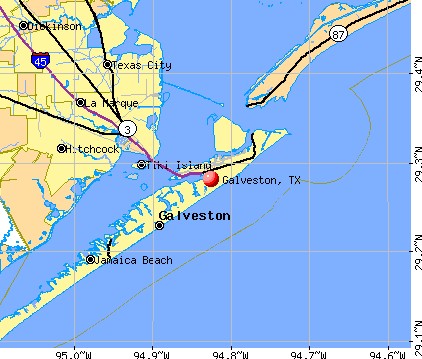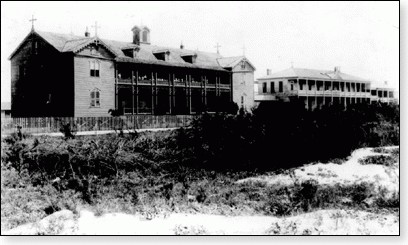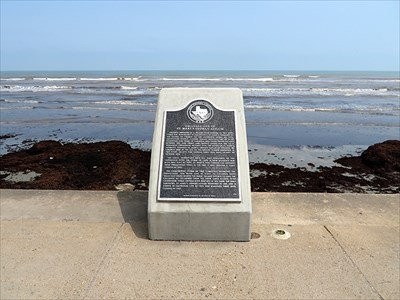St. Mary's Orphan Asylum (1867-1900)
Introduction
Text-to-speech Audio
This marker commemorates the 97 lives perished on the dreadful day of September 8, 1900. The St. Mary's Orphan Asylum, or "St. Mary's Orphanage," located at this marker, once housed 90 children and 10 sisters. Located in Galveston, Texas, the orphanage was destroyed on September 8, 1900 when the great hurricane reached the coast of Texas. All but three children died due to being tied together. As the water approached, the ropes prevented them from moving freely, and they drowned. The marker, which was erected in 1994, tells the story of the events that happened on that day, and acts as a reminder of the mistakes made during the Hurricane of 1900.
Images
This map of Galveston, Texas shows the geography of the city and its likeness to an island.

The St. Mary's Orphan Asylum housed 90 children at the time of the hurricane, and included two seperate dormitories - one for boys and one for girls.

This marker, located at 69th Street and Seawall Boulevard, tells the story of the disaster on the orphanage.

Backstory and Context
Text-to-speech Audio
On September 8, 1900, a category 4 hurricane hit the southernmost coast of Texas. Among the places to receive the most damage was the town of Galveston, Texas, which laid in the direct path of the storm. The hurricane came as a surprise to the island-city, despite various warnings. Weather-observers in Cuba dispatched to Galveston, warning of a deadly storm on its way, but all warnings were ignored. Therefore, by time the storm made landfall, the citizens of Galveston were faced with the decision of sticking out the storm, or finding higher ground. Others heeded the warnings from observers, but due to never having experienced any kind of big storm before, made simple mistakes. Had those mistakes been avoided, the casualties might have been far fewer. At the site of this marker lies the story of one of the simple mistakes made on that day.
As the Hurricane of 1900, as it was later called, made its way to Texas, there were few citizens who actually believed the warnings that a storm was on its way. Newer technology seemed unreliable, and some citizens put all their faith into the structure of the homes they had built, claiming that the better houses could withstand any storm. Of all the excuses for not seeking shelter, the greatest excuse derived from the idea that it was physically impossible for hurricanes to reach Texas. Basing their thoughts on prior knowledge, many believed that hurricanes could only travel northeast. The Hurricane of 1900 suddenly changed courses and traveled northwest, causing much disbelief as to whether Galveston would really receive the impact of the storm.
The St. Mary's Orphanage, located on the coast of Galveston Island, housed 90 children and 10 women at the time of the storm. The orphanage was first located inside the St. Mary's Infirmary, also located in Galveston, which opened in 1867 by the Sisters. Many children were orphaned due to the Yellow Fever, and a few years later, the Sisters moved the orphanage from inside the hospital to its new location three miles away on the beach; this location seemed promising as it was a good distance away from the city, and the Yellow Fever.1 The orphanage was one of the first structures to be hit when the storm made landfall. As it became evident that a storm was approaching, the sisters who ran the orphanage prepared for the damage. All of the children were moved into the girls' complex because it was newer and more likely to withstand the water. "The sisters cut the clothesline rope into sections and used it to tie the children to the cinctures which they wore around their waists. Each Sister tied to herself between six to eight children...some of the older children climbed onto the roof of the orphanage."3. Unaware of the absolute severity of the storm, the sisters believed they could help keep everyone together by tying the children to themselves. Once the water reached the orphanage, the clothesline prevented anyone from escaping. What the sisters thought was an escape tactic really caused the deaths of the orphanage children. They were later found on the beach, having all drowned to death from being tied together. Only three older children escaped, due to having climbed onto the roof.
The Hurricane of 1900 was deemed the deadliest hurricane the United States has ever witnessed; although the storm was strong, the casualties were so high because of careless mistakes and neglect to warnings. The hurricane resulted in so many casualties, Galveston eventually raised the city to prevent future damage, and filled in the raised section with concrete to ensure that dead bodies could never resurface; it served as a graveyard for those who died. Today, the site of the St. Mary's Orphanage, which sits on 69th Street and Seawall Boulevard, faces a Walmart Supercenter. The site of the orphanage received this marker on September 8, 1994.
As the Hurricane of 1900, as it was later called, made its way to Texas, there were few citizens who actually believed the warnings that a storm was on its way. Newer technology seemed unreliable, and some citizens put all their faith into the structure of the homes they had built, claiming that the better houses could withstand any storm. Of all the excuses for not seeking shelter, the greatest excuse derived from the idea that it was physically impossible for hurricanes to reach Texas. Basing their thoughts on prior knowledge, many believed that hurricanes could only travel northeast. The Hurricane of 1900 suddenly changed courses and traveled northwest, causing much disbelief as to whether Galveston would really receive the impact of the storm.
The St. Mary's Orphanage, located on the coast of Galveston Island, housed 90 children and 10 women at the time of the storm. The orphanage was first located inside the St. Mary's Infirmary, also located in Galveston, which opened in 1867 by the Sisters. Many children were orphaned due to the Yellow Fever, and a few years later, the Sisters moved the orphanage from inside the hospital to its new location three miles away on the beach; this location seemed promising as it was a good distance away from the city, and the Yellow Fever.1 The orphanage was one of the first structures to be hit when the storm made landfall. As it became evident that a storm was approaching, the sisters who ran the orphanage prepared for the damage. All of the children were moved into the girls' complex because it was newer and more likely to withstand the water. "The sisters cut the clothesline rope into sections and used it to tie the children to the cinctures which they wore around their waists. Each Sister tied to herself between six to eight children...some of the older children climbed onto the roof of the orphanage."3. Unaware of the absolute severity of the storm, the sisters believed they could help keep everyone together by tying the children to themselves. Once the water reached the orphanage, the clothesline prevented anyone from escaping. What the sisters thought was an escape tactic really caused the deaths of the orphanage children. They were later found on the beach, having all drowned to death from being tied together. Only three older children escaped, due to having climbed onto the roof.
The Hurricane of 1900 was deemed the deadliest hurricane the United States has ever witnessed; although the storm was strong, the casualties were so high because of careless mistakes and neglect to warnings. The hurricane resulted in so many casualties, Galveston eventually raised the city to prevent future damage, and filled in the raised section with concrete to ensure that dead bodies could never resurface; it served as a graveyard for those who died. Today, the site of the St. Mary's Orphanage, which sits on 69th Street and Seawall Boulevard, faces a Walmart Supercenter. The site of the orphanage received this marker on September 8, 1994.
Sources
1. Galveston County Daily News. The Sister's of Charity Orphanage. The 1900 Storm: Galveston Island, Texas. City of Galveston 1900 Storm Committee. 2014. Accessed November 14, 2017. www.1900storm.com/orphanage.html.
2. Galveston Texas Profile. City-Data. Advameg, Inc. 2017. Accessed November 14, 2017. www.city-data.com/city/Galveston-Texas.html.
3. Original Site of the St. Mary's Orphan Asylum. Waymarking. May 27, 2007. Accessed November 14, 2017. Retrieved from www.waymarking.com/waymarks/WM1KGA_Original_Site_of_St_Marys_Orphan_Asylum.
2. Galveston Texas Profile. City-Data. Advameg, Inc. 2017. Accessed November 14, 2017. www.city-data.com/city/Galveston-Texas.html.
3. Original Site of the St. Mary's Orphan Asylum. Waymarking. May 27, 2007. Accessed November 14, 2017. Retrieved from www.waymarking.com/waymarks/WM1KGA_Original_Site_of_St_Marys_Orphan_Asylum.
